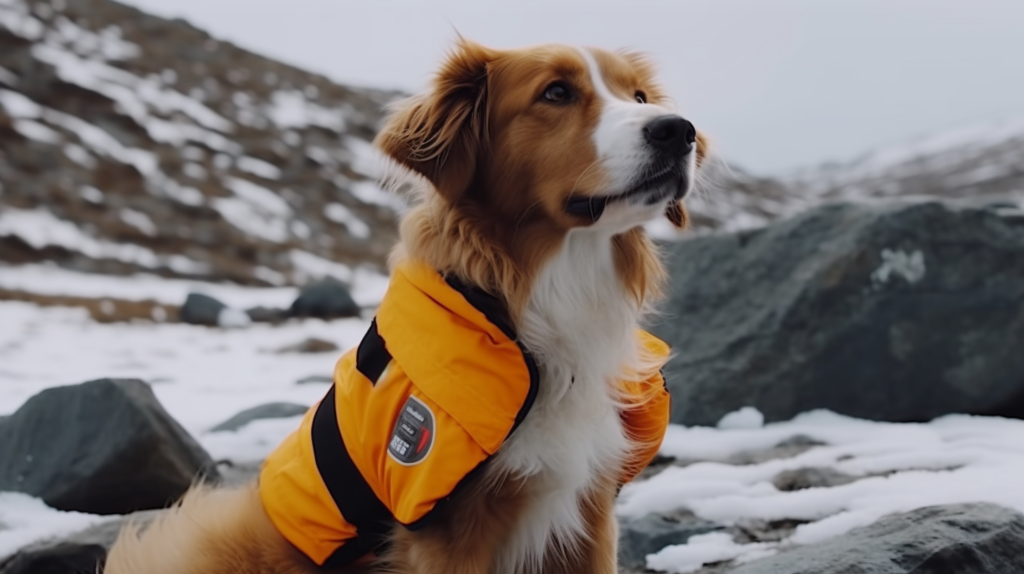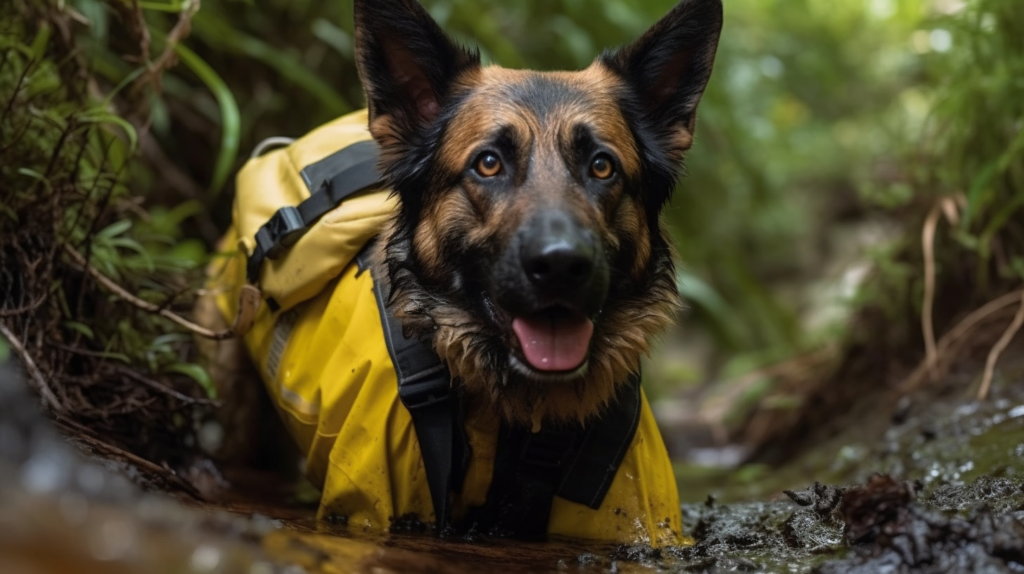
Search and rescue dogs play a crucial role in locating missing persons and providing assistance in emergency situations. Their unique abilities and specialized training make them invaluable assets in search and rescue missions. This article will explore the history and types of search and rescue dogs, as well as the qualities and characteristics that make a successful search and rescue dog. We will also delve into the various training methods used to prepare these dogs for their important work, including scent detection, tracking and trailing, and water rescue training.
Additionally, we will discuss the importance of building a strong bond with your search and rescue dog through trust, communication, positive reinforcement, and teamwork. Lastly, we will cover the necessary preparations for search and rescue missions, including physical fitness, equipment and gear, emergency first aid training, and navigation skills.
Key Takeaways
- Search and rescue dogs are trained to locate missing persons and provide assistance in emergency situations.
- There are different types of search and rescue dogs, including air-scenting dogs, trailing dogs, and water rescue dogs.
- Successful search and rescue dogs possess qualities such as intelligence, agility, and a strong work ethic.
- Training methods for search and rescue dogs include basic training, scent detection training, tracking and trailing training, and water rescue training.
- Building a strong bond with your search and rescue dog is essential for effective teamwork and communication.
History of Search and Rescue Dogs
Search and rescue dogs have been used for centuries to locate and save people in various emergency situations. These highly trained canines have a long and storied history, dating back to ancient times. In fact, the use of dogs in search and rescue can be traced back to the Roman Empire, where they were employed to find and retrieve lost soldiers on the battlefield.
Throughout history, different breeds of dogs have been utilized for search and rescue missions. Bloodhounds, with their exceptional sense of smell, were often used to track and locate missing persons. Other breeds, such as German Shepherds and Labrador Retrievers, are known for their intelligence, agility, and trainability, making them well-suited for search and rescue work.
Here is a brief overview of the history of search and rescue dogs:
| Time Period | Key Developments |
|---|---|
| Ancient Times | Dogs used by the Roman Empire to find lost soldiers |
| 18th and 19th Centuries | Bloodhounds used for tracking and locating missing persons |
| 20th Century | German Shepherds and Labrador Retrievers become popular breeds for search and rescue |
It is fascinating to see how search and rescue dogs have evolved over time, adapting to the changing needs and challenges of rescue operations. Today, these remarkable animals continue to play a vital role in saving lives and providing hope in times of crisis.
Types of Search and Rescue Dogs
There are several types of search and rescue dogs that are trained to specialize in different areas. These dogs are carefully selected and trained to perform specific tasks based on their breed and abilities. One such type is the air-scenting dog, which is trained to detect human scent in the air and locate missing persons. These dogs are often used in wilderness searches where the scent can be easily carried by the wind. Another type is the tracking dog, which is trained to follow a specific scent trail left by a person. These dogs are highly skilled at tracking and can follow a scent for miles, even in challenging terrain.
In addition to air-scenting and tracking dogs, there are also water search and rescue dogs. These dogs are trained to locate and rescue people in water, whether it’s in lakes, rivers, or even the ocean. They are skilled swimmers and are trained to use their powerful sense of smell to locate individuals in distress. Lastly, there are avalanche search and rescue dogs, which are specifically trained to locate people buried under snow after an avalanche. These dogs are trained to detect human scent under several feet of snow and can quickly locate and dig out victims.
Here is a table summarizing the different types of search and rescue dogs:
| Type of Search and Rescue Dog | Specialization |
|---|---|
| Air-scenting dog | Detecting human scent in the air |
| Tracking dog | Following a specific scent trail |
| Water search and rescue dog | Locating and rescuing people in water |
| Avalanche search and rescue dog | Locating people buried under snow |
It’s important to note that these types of search and rescue dogs often work together in teams, complementing each other’s skills and abilities to increase the chances of a successful search and rescue mission.
Qualities and Characteristics of a Search and Rescue Dog
Search and rescue dogs possess a unique set of qualities and characteristics that make them highly effective in their role. These dogs are known for their exceptional sense of smell, which allows them to detect scents from long distances and in various environments. They are also highly intelligent and trainable, making them quick learners and adaptable to different situations.
In addition to their physical abilities, search and rescue dogs also possess strong work ethic and determination. They are driven by a natural instinct to search for and locate missing persons, and they will not give up until the task is completed. These dogs are also known for their loyalty and dedication to their handlers, forming a strong bond that is essential for successful search and rescue missions.
To summarize the qualities and characteristics of a search and rescue dog, refer to the table below:
| Qualities and Characteristics |
|---|
| Exceptional sense of smell |
| High intelligence and trainability |
| Strong work ethic and determination |
| Loyalty and dedication to handler |
It is important to note that not all dogs possess the necessary qualities and characteristics to become search and rescue dogs. It requires a specific combination of traits and a rigorous training process to develop these skills. However, for those dogs that do possess these qualities, they have the potential to make a significant impact in search and rescue operations.
Training Methods for Search and Rescue Dogs

Basic Training for Search and Rescue Dogs
Basic training is the foundation for a successful search and rescue dog. It is crucial to establish a strong bond and clear communication with your dog from the beginning. Consistency is key in training, as search and rescue dogs need to follow commands accurately and quickly in high-pressure situations.
One important aspect of basic training is teaching your dog to respond to their name. This is essential for effective communication during search missions. Start by using your dog’s name in a positive and enthusiastic tone, rewarding them with treats or praise when they respond. Gradually increase the distractions and distance to ensure they can recognize their name in various environments.
To ensure your search and rescue dog is well-prepared, it is important to focus on the following areas:
- Obedience training: Teach your dog basic commands such as sit, stay, come, and heel. These commands are essential for control and safety during search missions.
- Leash training: Train your dog to walk calmly on a leash without pulling or lunging. This is important for maintaining control and focus during search operations.
- Socialization: Expose your dog to various environments, people, and animals to ensure they are comfortable and confident in different situations.
Remember, basic training is just the beginning. It lays the foundation for more advanced training in scent detection, tracking, and water rescue. Building a strong foundation through basic training will set your search and rescue dog up for success in their important role.
Scent Detection Training
Scent detection training is a crucial aspect of search and rescue dog training. The ability to locate and identify specific scents is essential for search and rescue dogs. This training involves teaching dogs to recognize and alert their handlers to the presence of certain odors, such as human scent or the scent of a specific item. Dogs are trained to use their powerful sense of smell to track and locate individuals who may be lost or in danger.
During scent detection training, dogs are exposed to various scents and are taught to associate those scents with a reward, such as a treat or a toy. This positive reinforcement helps to motivate the dogs and reinforce their ability to detect and indicate the presence of the target scent.
To ensure accuracy and reliability, scent detection training often includes rigorous testing and certification processes. Dogs must demonstrate their proficiency in detecting and indicating the target scent in various scenarios and environments.
In addition to the training techniques mentioned above, scent detection training may also involve the use of specialized equipment, such as scent detection kits or scent articles, to simulate real-life search and rescue situations.

Tracking and Trailing Training
Tracking and trailing training is a crucial aspect of search and rescue dog training. This training focuses on teaching dogs to follow and locate specific scents left by missing individuals. Dogs are trained to track scents on various surfaces, including grass, dirt, and concrete. They learn to differentiate between different scents and follow the trail to find the person in need.
During tracking and trailing training, handlers use a variety of techniques to enhance the dog’s ability to track scents. One common technique is the use of scent articles, which are items that have been in contact with the missing person and carry their scent. These articles are strategically placed along the trail to help the dog stay on track and follow the scent.
In addition to scent articles, handlers may also use rewards and positive reinforcement to motivate the dog during tracking and trailing training. By rewarding the dog for successfully following the scent and finding the target, the dog learns to associate the behavior with a positive outcome.
To ensure the dog’s safety during tracking and trailing missions, it is important for handlers to continuously assess the dog’s physical condition and monitor for signs of fatigue or injury. Dogs should be given regular breaks and provided with adequate hydration to prevent exhaustion. By maintaining the dog’s physical fitness and well-being, they can perform at their best during search and rescue operations.
Water Rescue Training
Water rescue training is a crucial aspect of search and rescue dog training. These highly skilled dogs are trained to assist in water-based rescue operations, such as locating and retrieving drowning victims. Their ability to navigate through water and their strong swimming skills make them invaluable assets in these situations.
During water rescue training, dogs are taught to respond to specific commands and signals while in the water, as well as how to safely approach and assist individuals in distress. They are also trained to use specialized equipment, such as life jackets and rescue buoys, to aid in their rescue efforts.
In addition to their physical training, search and rescue dogs undergo extensive mental preparation for water rescue missions. They are exposed to various water environments, including lakes, rivers, and pools, to familiarize them with different water conditions and ensure they are comfortable and confident in these settings. This exposure helps them develop the necessary skills to navigate through challenging water obstacles and locate victims efficiently.
To ensure the safety and effectiveness of water rescue operations, search and rescue dog handlers must also receive specialized training. They learn how to properly handle and control their dogs in water, as well as how to assess and mitigate potential risks. This training includes techniques for managing water currents, assessing water depths, and understanding the impact of weather conditions on water rescue operations.
Water rescue training is a demanding and rigorous process that requires a strong bond between the search and rescue dog and their handler. The trust and communication established between them are essential for successful water rescue missions. Through consistent training, positive reinforcement, and teamwork, search and rescue dogs and their handlers become a highly efficient and reliable team, ready to respond to emergencies and save lives.
Building a Strong Bond with Your Search and Rescue Dog

Establishing Trust and Communication
Building a strong bond with your search and rescue dog starts with establishing trust and communication. This is crucial for effective teamwork and successful missions. One way to establish trust is through consistent and clear communication. Use verbal cues and body language to convey your intentions and expectations to your dog.
Additionally, active listening is essential in building trust. Pay attention to your dog’s body language and signals, and respond accordingly. This will help your dog feel understood and valued as a partner.
To further strengthen the bond, spend quality time with your dog outside of training sessions. Engage in activities that your dog enjoys, such as playing fetch or going for walks. This will create positive associations and reinforce the bond between you and your dog.
Remember, trust and communication are the foundation of a strong partnership with your search and rescue dog.
Positive Reinforcement Techniques
Positive reinforcement techniques are a crucial aspect of training search and rescue dogs. These techniques involve rewarding desired behaviors to encourage their repetition. By using positive reinforcement, handlers can effectively communicate with their dogs and motivate them to perform tasks. It is important to note that positive reinforcement should be used consistently and immediately after the desired behavior is exhibited.
One effective positive reinforcement technique is the use of treats or toys as rewards. When the dog successfully completes a task or exhibits the desired behavior, they are given a treat or allowed to play with a toy. This creates a positive association with the behavior and encourages the dog to continue performing it.
In addition to treats and toys, verbal praise and affection are also powerful forms of positive reinforcement. Dogs thrive on praise and attention from their handlers, and verbal cues such as ‘good boy’ or ‘well done’ can reinforce desired behaviors.
It is important to remember that positive reinforcement should be used in conjunction with clear and consistent commands. Dogs need to understand what is expected of them in order to perform the desired behavior. By combining positive reinforcement with effective communication, handlers can build a strong bond with their search and rescue dogs and achieve successful training outcomes.
Socialization and Exposure
Socialization and exposure are crucial aspects of search and rescue dog training. Proper socialization helps dogs become comfortable and confident in various environments and situations, which is essential for their success in search and rescue missions.
One effective way to socialize search and rescue dogs is through controlled exposure to different stimuli. This can include introducing them to various sounds, smells, and surfaces they may encounter during a mission. By gradually exposing them to these stimuli in a positive and controlled manner, dogs can learn to remain calm and focused in challenging situations.
In addition to socialization, search and rescue dogs also need exposure to different types of terrain and environments. This helps them develop the necessary skills and adaptability to navigate through various landscapes, including forests, mountains, and urban areas.
To ensure thorough socialization and exposure, trainers often create a structured training plan that includes specific goals and milestones. This plan may involve regular outings to different locations, interactions with various people and animals, and exposure to different types of weather conditions.
By prioritizing socialization and exposure in search and rescue dog training, handlers can help their dogs become well-rounded and confident in any situation they may encounter during a mission.

Teamwork and Partnership
Building a strong partnership between the handler and the search and rescue dog is crucial for successful missions. Trust is the foundation of this partnership, as the handler must trust the dog’s abilities and instincts, while the dog must trust the handler’s guidance and direction. Effective communication is also essential, with the handler using clear and consistent commands to direct the dog’s actions.
To enhance the partnership, regular training sessions should focus on reinforcing the bond between the handler and the dog. These sessions can include activities such as obedience training, agility exercises, and problem-solving tasks. By working together in various scenarios, the handler and dog can develop a deeper understanding of each other’s strengths and weaknesses.
In addition to training, it is important for the handler to provide the search and rescue dog with proper care and attention. This includes regular exercise, a balanced diet, and regular veterinary check-ups. By taking care of the dog’s physical and emotional well-being, the handler can ensure that the partnership remains strong and the dog is ready for any search and rescue mission.
Table: Key Elements of a Strong Partnership
| Element | Description |
|---|---|
| Trust | The foundation of the partnership, with the handler and dog relying on each other |
| Communication | Clear and consistent commands to direct the dog’s actions |
| Training | Regular sessions to reinforce the bond and develop a deeper understanding |
| Care and Attention | Proper care, exercise, and veterinary check-ups to maintain the dog’s well-being |
Building a strong partnership between the handler and the search and rescue dog is not only essential for successful missions but also for the overall well-being of the dog. By establishing trust, effective communication, and providing proper care, the handler and dog can form a strong bond that enables them to work together seamlessly in any search and rescue situation.
Preparing for Search and Rescue Missions
Physical Fitness and Conditioning
Regular physical fitness and conditioning are essential for search and rescue dogs to perform their duties effectively. Maintaining a high level of fitness allows these dogs to endure long hours of searching and navigate challenging terrains. A combination of cardiovascular exercises, strength training, and agility exercises helps to build endurance, strength, and flexibility.
Here are some key aspects of physical fitness and conditioning for search and rescue dogs:
- Cardiovascular exercises: These exercises, such as running or swimming, help improve the dog’s stamina and cardiovascular health.
- Strength training: Building strength through exercises like weight pulling or obstacle courses helps the dog to carry out tasks that require physical exertion.
- Agility exercises: Agility training, including jumping over obstacles or navigating through tight spaces, enhances the dog’s coordination and flexibility.
It is important to gradually increase the intensity and duration of the exercises to prevent injuries and ensure the dog’s safety and well-being.
Equipment and Gear
When it comes to search and rescue missions, having the right equipment and gear is crucial. Safety should always be the top priority, and search and rescue teams must ensure they are well-equipped to handle any situation. Some essential equipment and gear for search and rescue missions include:
- Harnesses and Leashes: These are used to secure and control the search and rescue dogs during operations.
- GPS Devices: These devices help track the location of the search and rescue team and provide real-time updates.
- First Aid Kits: It is important to have a well-stocked first aid kit to treat any injuries or medical emergencies that may occur during a mission.
- Communication Devices: Radios, walkie-talkies, and other communication devices are essential for maintaining contact and coordination between team members.
Having the right equipment and gear not only ensures the safety of the search and rescue team but also enhances their effectiveness in locating and rescuing individuals in need.

Emergency First Aid Training
Emergency first aid training is a crucial aspect of search and rescue missions. The ability to provide immediate medical assistance can make a significant difference in saving lives. Search and rescue dogs handlers are trained in basic first aid techniques to address common injuries and medical emergencies that may occur during a mission.
In addition to basic first aid training, handlers also receive specialized training in administering CPR and performing rescue breathing techniques. These skills are essential in situations where a person is in cardiac arrest or experiencing respiratory distress.
During emergency first aid training, handlers also learn how to assess and stabilize injuries, such as fractures, wounds, and burns. They are taught how to properly apply bandages, splints, and dressings to provide temporary relief until professional medical help arrives.
It is important to note that search and rescue dog handlers are not medical professionals, but their training in emergency first aid allows them to provide immediate assistance and support until professional help can be obtained.
To ensure the safety and well-being of both the handler and the dog, it is crucial for search and rescue teams to regularly update their first aid training and stay informed about the latest techniques and protocols.
Navigation and Map Reading
Understanding navigation and map reading is crucial for search and rescue missions. Knowing how to interpret maps and navigate through different terrains is essential for search and rescue teams to effectively locate missing individuals or respond to emergency situations.
To ensure accurate navigation, search and rescue dog handlers undergo extensive training in map reading and compass use. They learn how to identify key landmarks, plot coordinates, and calculate distances. This knowledge allows them to create effective search plans and navigate their way through challenging environments.
In addition to map reading skills, search and rescue dog handlers also rely on advanced technology such as GPS devices and satellite imagery. These tools provide real-time information on the team’s location and help them track their progress during a mission.
To summarize, navigation and map reading skills are essential for search and rescue dog handlers. By combining their knowledge of maps, compasses, and technology, they can navigate through various terrains and effectively carry out their search and rescue missions.

Conclusion
In conclusion, training search and rescue dogs is a challenging yet rewarding endeavor. It requires a combination of specialized skills, dedication, and a deep bond between the handler and the dog. By following the principles outlined in this article, aspiring search and rescue dog trainers can set themselves up for success. These remarkable dogs play a vital role in saving lives and providing hope in times of crisis. With proper training and ongoing practice, search and rescue dogs can continue to make a significant impact in the field of emergency response.
Frequently Asked Questions
What breeds are commonly used as search and rescue dogs?
Commonly used breeds for search and rescue work include German Shepherds, Labrador Retrievers, Golden Retrievers, and Border Collies.
At what age can a dog start search and rescue training?
Dogs can start search and rescue training as early as 8 weeks old, but the intensity and complexity of training will vary based on the dog’s age and breed.
How long does it take to train a search and rescue dog?
The training duration for a search and rescue dog can vary depending on the dog’s breed, age, and previous training experience. It can take anywhere from several months to a few years to fully train a search and rescue dog.
What skills are important for a search and rescue dog to possess?
Important skills for a search and rescue dog include obedience, agility, scent detection, tracking, and swimming ability. They should also have a strong drive to work and a good temperament.
Can any dog be trained as a search and rescue dog?
While any dog can potentially be trained for search and rescue work, certain breeds and individual dogs are better suited for the task due to their physical abilities, temperament, and drive to work.
What is the role of the handler in search and rescue missions?
The handler plays a crucial role in search and rescue missions. They are responsible for directing the dog, maintaining communication, interpreting the dog’s behavior, and ensuring the safety of both the dog and the search team.

